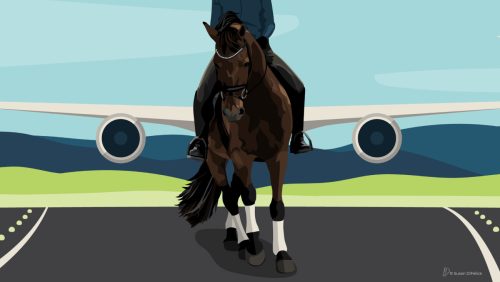Dressage teams around the world are gearing up for a serious showdown at the Olympic Games in Paris where the best in the world go head-to-head over four days. As in Tokyo, each team is made up of three horse-and-rider combinations, with no drop score.
The United States will be represented by five-time Olympian Steffen Peters with Suppenkasper in their second Olympic appearance together after earning “Rave Horse” fame in Tokyo; two-time Olympian Adrienne Lyle (who joined Peters on the 2021 Olympic silver medal-winning team) with her new ride Helix; and first-timers Marcus Orlob and Jane. Endel Ots and Bohemian are the traveling reserves.

They’ll have their work cut out for them, facing powerhouse teams from Germany and Denmark, while Great Britain strives to rebound from a scandal last week that saw Charlotte Dujardin, its top-ranked rider, replaced by the traveling alternate. Those teams include the likes of Germany’s Jessica von Bredow-Werndl, who is bringing TSF Dalera BB, with whom she swept the Tokyo Olympic Games and won two FEI World Cup Finals in Omaha (Nebraska) and Leipzig (Germany). Then there’s her teammate, legend Isabell Werth who’s bringing a wealth of experience with six Olympic Games with eight Olympic golds on her record. She’ll have Wendy, fresh off winning all three of her classes at the Aachen CDIO5* (Germany).
For Great Britain, Lottie Fry already has a team Olympic bronze from Tokyo, and she’s bringing her gold medal partner from the 2022 Blue Hors Dressage World Championship, Glamourdale. Carl Hester, in his seventh Olympic appearance, will bring Fame. Joining the two will be Becky Moody and her homebred mare Jagerbomb, ranked No. 14 in the world, to replace the No. 4-ranked Dujardin, who is provisionally suspended from competition.
Denmark’s team includes Cathrine Laudrup-Dufour making her third trip to the Olympics, this time aboard Freestyle, and her resume includes team gold at the last world championship.

You can see all the definite entries here.
ADVERTISEMENT
When: July 30-31, Aug. 3-4
Medal Days: Team—Aug. 3
Individual—Aug. 4
Where: The Park at Versailles in Paris
How To Watch: PeacockTV.com will be streaming all equestrian sports live. (All times Eastern.) Other networks will have replays.
• Grand Prix Day 1 (team and individual)—5 a.m. Tuesday on Peacock; 11 a.m. Tuesday on E! The first U.S. horse will be 17th in the ring, with Olympic first timers Marcus Orlob in Jane at 7:57 a.m. ET, followed by Adrienne Lyle and Helix at 11:52 a.m. ET.
• Grand Prix Day 2 (team and individual)—4 a.m. Wednesday on Peacock; 10 a.m. Wednesday on E! The final U.S. pair, Steffen Peters and Suppenkasper go at 11:01 a.m. ET.
• Grand Prix Special (team final) and team medals—4 a.m. Saturday on Peacock; 3 p.m. Saturday on E!
• Grand Prix freestyle (individual final) and individual medals—4 a.m. Sunday on Peacock; 3:45 p.m. Sunday on E!
ADVERTISEMENT
How The Team Medals Are Decided: All 60 horse-and-rider combinations compete in the Grand Prix test, which serves as the qualifying competition for the individual final (the Grand Prix freestyle) and the team final (the Grand Prix Special).
Athletes compete in six groups, with three groups competing Tuesday and the remaining three Wednesday. The groups are determined by the FEI World Ranking List position of the Horse as of July 8. Each group is similarly weighted between higher- and lower-ranking riders.
All teams receive a qualification ranking after the Grand Prix test by adding up the three results per team. The top 10 ranked teams—including those tied for 10th—qualify for the clean-slate Grand Prix Special. No individuals will ride in the Special.
Teams may substitute in their reserve horse-and-rider pair—after the Grand Prix and up to two hours before the Special—if one of the previous three pairs can’t compete due to veterinary or medical reasons. No penalties are levied for substitutions in dressage, but a substituted horse-and-rider pair cannot contest the freestyle.
The final score for each team is calculated by adding the final total percentages in the Grand Prix Special from each team member. The country with the highest total score wins.
How The Individual Medals Are Decided: The top 18 riders—the top two from each of the six groups, plus the six with the next-highest scores—from the Grand Prix test qualify for the Grand Prix freestyle on Sunday to vie for individual medals, which are again based on scores from that single test. Horses qualifying for the freestyle must pass a second horse inspection. Once again, the highest score wins.














